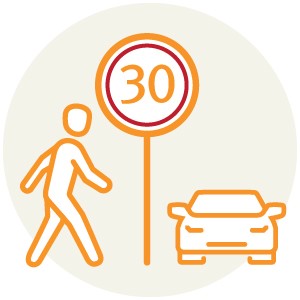Speed management and integrated treatments
On this page
Speed management
Safe speeds are a key component of the Safe System. The Safe System aspires to interaction speeds of around 30 km/h where pedestrians are involved.
For additional guidance for local governments on introducing lower urban speed limits, email TMR.Speed@tmr.qld.gov.au
TMR endorsed guidance
- TRUM Volume 1 Part 6 Interchanges, intersections and crossings (Department of Transport and Main Roads, 2019)
- Queensland Road Safety Technical User Volumes (QRSTUV): Guide to Speed Management (Department of Transport and Main Roads, 2022)
Other useful resources
- Guide to Traffic Management Part 4: Network Management Strategies, Section 4.7.3 Management Principles (Austroads, 2020)
- Guide to Traffic Management Part 6: Intersections, Interchanges and Crossings Management, Table 9.4: Benefits of treatments – integrated facilities (Austroads, 2020)
- Guide to Traffic Management Part 7: Activity Centre Traffic Management, Section 4.6 Traffic calming and speed management and Appendix E Speed Management in Pedestrian Areas (Austroads, 2020)
- Integrating Safe System with Movement and Place for Vulnerable Road Users (Austroads, 2020)
- Safe Systems in the Planning Process (Austroads, 2015)
- Case study: ‘Reducing speed limits in areas with high walking and bike riding activity’, Walking in Queensland Report 2019, page 12 (Department of Transport and Main Roads, 2019).
- Global Street Design Guide, 1.5 Safe Streets Save Lives and 9.1 Design speed (Global Designing Cities Initiative, 2016)
- Achieving Lower Speeds: The Toolkit (Transport for London, 2019)
- City Limits: Setting Safe Speed Limits on Urban Streets (NACTO, 2020)
- Benefits of Lower Speed Limits (CWANZ, 2022)
Pedestrian malls and high-volume pedestrian locations
Pedestrian malls separate people walking and vehicles. They are open spaces specifically designed to support commercial activity and provide a pleasant environment in which people can conduct business, relax or be entertained. These spaces must provide for convenient and safe travel for all pedestrians.
Other high-volume pedestrian locations may include entertainment or sporting venues, major shopping centres, and footpaths and crossings in the CBD and other busy shopping areas.
TMR endorsed guidance
- Queensland Manual of Uniform Traffic Control Devices Part 4: Speed Controls, part 4.3.2 Shared Zones and 4.3.4 High Active Transport User Area Zone (Department of Transport and Main Roads, 2022)
- AS1742 Manual of uniform traffic control devices Part 10: Pedestrian control and protection, Section 10 Pedestrian Malls
Other useful resources
- Guide to Traffic Management Part 7: Activity Centre Traffic Management, Section 5.5 Pedestrian streets and transit malls (Austroads, 2020)
- Hostile Vehicle Guidelines for Crowded Places, Section 2, Trees and Fences (Attorney General's Department, 2017)
High Active Transport User Areas (HATUAs)
High Active Transport User Areas (HATUAs) encourage social activity and have a significant value to the community as a 'place' for people to gather.
Roads and streets that are considered to be within HATUAs have land uses and developments that generate or attract levels of pedestrians and cyclists that are considered higher than typical.
A speed limit of 30 km/h or 40 km/h may be adopted (subject to certain conditions).
TMR endorsed guidance
- Queensland MUTCD Part 4: Speed Controls
- Queensland Road Safety Technical User Volumes (QRSTUV): Guide to Speed Management
Shared zones
This is a zone with the speed limit applied to an area or length of road that is shared by vehicles and people walking and cycling.
Shared zones are generally constructed in areas where the competing demands of people walking, cycling, driving and parking require a form of control which allows complete and safe pedestrian mobility.
A speed limit of 10 km/h applies.
TMR endorsed guidance
- Queensland MUTCD Part 4: Speed Controls
- Queensland Road Safety Technical User Volumes (QRSTUV): Guide to Speed Management
Other useful resource
- Guide to Traffic Management Part 8: Local Street Management, Section 8.5.6 Shared zones (Austroads, 2020)
School zones
These are used to regulate the speed limit near schools.
TMR endorsed guidance
- Queensland Road Safety Technical User Volumes (QRSTUV): Guide to Speed Management
- Queensland MUTCD Part 4: Speed Controls
Other useful resources
- Guide to Traffic Management Part 8: Local Street Management, Section 8.5.7 School zones (Austroads, 2020)
Local access streets/residential streets
Local Area Traffic Management (LATM) involves modification of the street environment to achieve outcomes such as reduced speeds, reduced through-traffic, fewer crashes and improved amenity. Perimeter and internal treatments are generally used.
The default speed limit for a road in a built-up area is 50 km/h. A speed limit of 40 km/h may be adopted in local areas (subject to certain conditions).
TMR endorsed guidance
- Queensland MUTCD Part 4: Speed Controls
- Queensland Road Safety Technical User Volumes (QRSTUV): Guide to Speed Management
- AS1742 Manual of uniform traffic control devices Part 13: Local Area Traffic Management
Other useful resource
- Guide to Traffic Management Part 8: Local Street Management, Section 9.12.2 Providing for Pedestrians in LATM and Section 4.2.2 Data Collection (Austroads, 2020)
- Last updated 31 March 2023

